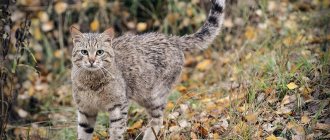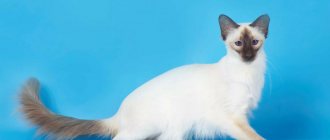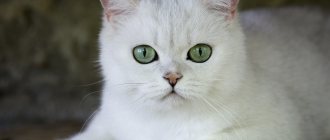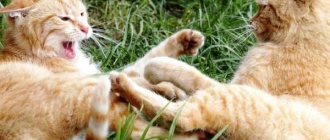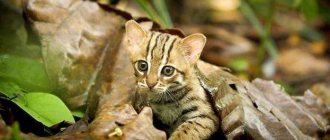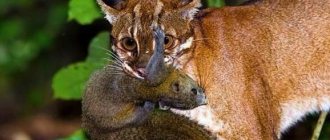Sokoke is a slender, muscular cat with long flexible legs and short fur, the contrasting pattern of which imitates the texture of tree rings. Its primitive beauty, combined with the independent disposition and grace of a wild predator, is highly appreciated by leading felinologists and becomes the subject of admiration for ordinary owners.
Let's figure out what's hidden behind the exotic appearance of a Sokoke cat.
Brief history of the breed
Kenya is considered the homeland of Sokoke, and African forest cats are among their ancestors. For a long time they were known only to the aborigines. And the official history of the breed began in 1978, when the owner of a coconut plantation, Janie Slater, picked up a couple of cute kittens. After some time, the matured animals became parents, and their offspring were taken to Denmark and Italy.
In 1983, the breed received the official name – African Shorthair. But recognition came to her only 10 years later. In the early 2000s, Kenyan Ginny Nocker developed a new line of sokoke, representatives of which were exported to Europe and the USA.
Historical information about the breed
In the 70s of the last century, an Englishwoman, Jenny, discovered kittens with cheetah-like coloring in the Sokoke forest in Kenya. The breed began to be named after the forest where it was discovered - Sokoke. It was this woman from England who became the person who first started breeding them.
Ten years later, Jenny's friend began distributing these cats in Denmark. At first it was called the African Shorthair. But in 1992, the Danish government officially approved the name “Sokoke” for the breed.
At the same time, in the homeland of the Sokoke, in Kenya, various hybrids began to be bred on various private farms, up to the appearance of snow-colored cats.
The feline offspring of the breed in Kenya began to be called kazonzo, due to the fact that the color of the cat was similar to the bark of trees. They quickly jumped through the trees in search of food: small birds, rodents. Sokoke adopted many character traits from their predecessors.
The International Cat Breeding Organization has approved a new name for the breed. Now it is called soukok, although the more familiar name sokoke is firmly entrenched behind it. It is considered very rare, because there are no more than one hundred individuals in the world.
Interesting Facts
During the existence of the breed, many interesting things have been associated with it:
- Sokoke have several alternative names. These cats are also known as Kenyan Forest and Soukok cats.
- A special study was conducted to establish the natural origin of sokoke. As a result, it was found out that they have a common DNA structure with the spotted street cats of Eastern Kenya and the cats of Lamu Island. Based on this, the Kenyan Forest was included in a separate racial group called the Arabian Sea.
- In ancient times, when cattle were considered a luxury item, Kenyan aborigines consumed sokoke as food.
- Due to the spiral wood pattern on their brown fur, forest cats were called "kanzonzo", which means "bark-like".
Origin story
The history of Sokoke began in the Sokoke region of Kenya.
Local resident Jenny Slater, while processing a coconut plantation, found an unusual type of kitten there. The kids were absolutely wild, but so beautiful in appearance that she took a couple with her. The kittens took root in her house, created a pair, and gave birth to kittens. Through word of mouth, the kids began to be adopted as a new breed of Sokoke: several went to Italy, others to Denmark.
A few years later, curious people explored the breed. It turned out that the DNA of these cats is similar to the DNA of the cats of the distant island of Lamu, as well as the street cats of Eastern Kenya. It was decided to inject fresh blood into the breed, and in 2008 it was officially recognized by the International Cat Association.
There is one Sokoke nursery in Russia - in Moscow. Cats are also raised in Ukraine. A baby not for breeding and without documents costs about 30,000 thousand rubles. A show-class specimen costs much more: up to 100,000 rubles.
Breed description, standards, appearance
Sokoke is an athletic cat with well-developed muscles, graceful movements and short, close-lying hair. A detailed description of the Kenyan Forest is presented in the generally recognized breed standard.
Dimensions and weight
Sokoke is a medium-sized cat. There is sexual dimorphism in the breed, so males are noticeably larger and heavier than females. An adult cat weighs on average about 5 kg. The weight of a cat usually does not exceed 3 kg.
Anatomical characteristics
A typical Kenyan forest cat should fit the following description:
- The head is graceful, wedge-shaped, with high pronounced cheekbones, a strong chin and neat mustache pads.
- The ears are medium in size, with a wide base and slightly rounded tips. Can be decorated with fluffy tassels.
- The nose is straight, wide, moderately long. Has a slight bend at the bridge of the nose.
- The eyes are almond-shaped, wide-set, slightly inclined towards the base of the ears. The Kenyan forest iris has a black rim and can be colored amber or light green.
- The body is flexible, athletic, moderately elongated, with rounded sides, a developed chest and a muscular neck.
- The limbs are slender, long, with small oval paws. The Sokoke's front legs are shorter than its hind legs, making the cat appear to walk on tiptoes.
- The tail is long, gradually tapering from base to tip.
Color and coat type
The body of the Kenyan forest cat is covered with short, coarse, close-fitting hair with little or no down.
Sokoke has two color options:
- Standard tabby with a brown background and black and brown markings. The paw pads are dark colored.
- Snow tabby with a clear contrasting pattern on a light ivory background. The nose and paw pads of these Kenyan forest cats are pigmented pink. The eyes of Sokoke with snow tabby color are light blue without any amber or green tint.
The main color features of the Kenyan Forest Cat include a necklace around the neck, a bull's eye pattern on the side, a broken "M" on the forehead and a butterfly pattern on the back.
Possible breed defects
Defects for which Sokoke is subject to disqualification:
- Kenyan forest cats have blue eyes with a classic color;
- rounded body contours;
- plump cheeks;
- clear transition from head to body;
- White spots.
Sokoke cat
This amazing breed originates from a Kenyan forest representative of wild African fauna. In the language of local tribes it was also called Hadzonzo. Sometimes the animals are also called Kenyan soukok. They are considered not a direct product of selection by felinologists, but a product of the very nature of the distant southern continent. The Sokoke cat outwardly resembles such a representative of its extensive family as the cheetah. She is distinguished by her amazing body, slender limbs, and strong muscles. The animals are not very large in size. The male usually reaches 5 kilograms, the female does not exceed 3.
Origin story
The Sokoke cat breed has its descriptive origins in records dating back to the second half of the twentieth century. In 1978, D. Slater, a resident of Africa, discovered a litter of animals on her property. She liked the animals and decided to adopt them. Later she started breeding them. She soon designated them as the Sokoke or Soukok breed. She was joined by her friend G. Moldrup, who took kittens to exhibitions in the Scandinavian countries and then to Italy. At the beginning of the new millennium, the animals served as the beginning of a new popular breed. The Kenyan D. Nocker helped their popularization, who provided a theoretical basis for the appearance and characteristics of its representatives. She kept the cats, studied them in detail and recorded their differences. She began selling the cubs to other continents. She owns the main characteristics and description of the breed, as well as clarifying the character traits of Sokoke cats, D. Nocker has recorded numerous videos of handsome cats.
Description of the Sokoke breed
The animals are distinguished by their special appearance, which is difficult to confuse with representatives of other breeds.
- Head and body
The muzzle is small, wedge-shaped. Disproportionally small in relation to the body, long, resembling a triangle. Rounded contours of the skull, turning into dense cheeks with a lush mustache. The eyes are large and almond-shaped. The pupils are outlined in black. The nose is straight or slightly curved, pink in color. High cheekbones, pronounced chin Large, wide at the base, erect. The tips are slightly rounded, giving the cat a cheetah-like appearance. According to the instructions of felinologists, another ear should be placed between them. Small, lean, streamlined in shape. Medium in size, sharp at the end, ending in a dark wedge. Long, front ones somewhat shorter than rear ones. Pads are rounded, medium-sized
- Coat and color
Small cheetahs have an appearance that truly makes them similar to their wild relatives. Their fur resembles velvet and fits tightly to the skin. It feels a little rough to the touch and lacks undercoat. Important! The classic representative of the Sokoke family looks like an animal, painted in a pleasant dark yellow color, paler in the lower part of the body. Animals often have brown or black spots on their body as well as on their paw pads. The eyes are usually green. The color also stands out, which is called snow tabby by felinologists. It is distinguished by a distinct patterned pattern throughout the animal's fur. The base shade appears lighter than the previous type, approaching an ivory shade. Eye color is blue.
Character
This cat has a special disposition and a penchant for games and entertainment. The pet is very mobile and in the blink of an eye is able to completely change the usual environment of the apartment in which it lives. Therefore, it is better to constantly keep an eye on it if the owner does not want to collect the remains of a favorite vase from the floor or lament over the damaged upholstery of a chair. Sokoke's character is very complex. They are very sociable, but may not get along with other pets. They are completely devoted to humans, so it is recommended to take them to a child. Animals are very affectionate, patient, and will never harm him. Maintenance and care In order for a cat to remain healthy for a long time, it should be properly cared for. The main requirements for preserving the beauty of its appearance are the following: • washing the cat is required only when it is heavily soiled; • if it is not too dirty, just wipe it with a cloth; • it is advisable to allow the animal to swim in hot weather, since it is not afraid of water; • no need to comb it; • once every seven days the animal should be stroked with a soft brush.
Feeding
The cat must eat according to strict rules. The menu needs to be diversified. It must include fermented milk products, as well as a sufficient amount of meat. Interesting! If there are Sokoke kittens in the house, then you need to add vegetables or fruits to your food, foods that contain a lot of taurine or tocopherol. The African Shorthair cat will do better if kept on a home-cooked diet, although it is permissible to feed them a high-grade, balanced diet.
Health
Since Sokoke is based on the genotype of a wild cat, it is guaranteed chromosomal diversity. Animals do not become regular patients in veterinary clinics, but they should be subjected to professional examination from time to time to avoid the influence of infections. -Diseases and life expectancy The Kenyan forest cat is quite strong by nature. Representatives of the breed live for about 15 years and, as a rule, rarely get sick. You need to pay close attention to caring for their eyes and ears by cleaning them regularly. Considering that the Sokoke cat originates from Africa and is practically devoid of undercoat, it should be protected from colds. Males sometimes experience overexcitation during the period of activation of the sexual instinct. Sometimes they even show some aggressiveness, becoming tense.
How much does a Sokoke cat cost? A very important criterion is complete and exact compliance with all parameters of the breed’s exterior.
Choice of kitten and price
It is advisable for Sokoke to be owned by people who are willing to spend unlimited time caring for it. This African Shorthair cat loves to play and cannot stand being alone. There is no need to take her into a house where other animals already live. The owner's attention should belong to her undividedly. You need to monitor the room temperature and drafts very carefully, because such a pet catches colds easily. Kittens are highly valued by fanciers, so they can charge about 60,000 rubles for a cub with a pedigree. If the animal was bred by an amateur breeder or comes from a small club, then it can cost about 30,000. An elite animal is valued even at around one hundred thousand rubles.
What to pay attention to
Need to know! It is best to adopt a baby at the age of two to three months. During this time, the cat manages to completely complete the cycle of raising cubs. In addition, it can be difficult to make a mistake in choosing an animal, since its characteristic color speaks for itself, having time to be fully formed by this period. The remaining parameters also look quite clear.
Conclusions about the Sokoke Cat breed – natural grace, beauty, charm. When admired, it resembles the wild animals of its native African continent. His exotic beauty and pride will not leave even the most uninterested people indifferent.
Character and temperament
Kenyan Forest cats are energetic, playful cats and are unable to sit still for long periods of time. Despite their independent disposition, Sokoke are very attached to people and have difficulty withstanding separation. Kenyan forest cats always try to be closer to their beloved owner, but do not allow themselves to persistently demand attention.
Due to their easy-going and playful nature, Sokoke are great with children. Kenyan forest animals are tolerant of childish pranks and rarely use their claws.
Sokoke are friendly towards other pets. They easily find a common language not only with cats, but also with dogs.
Important! Difficulties may arise if there are small rodents or ornamental birds in the house. Sooner or later, the hunting instinct will awaken in the Kenyan forest, and the cat will find a way to get to the hamster or parrot.
Sokoke character
Sokoke cats are playful. They are characterized by activity, intelligence and intelligence. But the savagery of their descendants gave them willfulness and independence. It is impossible not to note their ability to become attached to their owners. They also have established communication with anyone who comes to visit and with some animals (cats of different breeds and dogs). An affectionate and calm character pacifies all family members (but due to a hereditary disease, cats have problems with the nervous system).
The peculiarity of “cheetah” cats is that, like trained animals, they can tirelessly jump, run, swim, and skillfully jump from one tree to the next. Such skills are already in the Sokoke’s blood; there is no need to teach them; the abilities were probably handed down by their ancestors. Although cats of this breed adapt to apartments, it is, of course, advisable to keep an exotic cat in a house with a large yard. After all, in the yard you can make a play corner with an imitation of a forest, perhaps install artificial trees, as well as sand and toys for cats.
Energy and a cheerful disposition need to go somewhere, but you should still fence the yard area with a fence to prevent escape. In this case, cats will not look for a place to play in rooms and will not damage furniture and objects in the house. The hunting instinct does not affect relationships with the outside world, but it is important to remember that poor nutrition can cause aggression. The advantage of cats is that they do not require much attention and can easily tolerate solitude while their owners are at work. But it is important to prepare everything for the pastime, given that Sokoke love a lot of free space.
At the end of the day, you can see how the pet missed its owner, happily greeting him. This breed does not have the habit of meowing disgustingly and asking for something, or lying near its owners. Their energy lasts for the whole day. During walks, Sokoke cats can accompany their owners. Fearlessness and masculinity help cats survive in unexpected situations. Cats are careful with children, do not show aggression, and love to play. It happens that they are frightened by the screams and pranks of children.
How to choose the right kitten
In the post-Soviet countries there are practically no nurseries that specialize in breeding the Sokoke cat breed. Therefore, a Kenyan Forest kitten will have to be imported from Europe.
When choosing a pet, you should pay attention to the following criteria:
- compliance with breed standards;
- conditions of detention;
- health status;
- behavior;
- Availability of pedigree and veterinary passport.
On a note. If it is not possible to choose a Kenyan forest kitten live, you should ask the breeder to send more photos and video materials.
Care and maintenance
The Kenyan Forest cat is a domestic cat and comfort is important to it. She does not like extraneous noise and needs space. Caring for Sokoke cats is not at all difficult and differs little from caring for representatives of other short-haired breeds.
To make the Kenyan forest look neat, it is regularly subjected to hygienic procedures:
- The cat's ears are cleaned weekly of accumulated dirt and dust. To do this, use cotton pads and special lotions without alcohol.
- Sokoke eyes are wiped daily with a soft natural cloth moistened with boiled water or herbal infusion.
- The Kenyan Forest's teeth are brushed 3-4 times a month with a special brush with a non-foaming paste to prevent the formation of tartar and prevent the development of dental diseases.
- As they grow, Sokoke's claws are trimmed with a nail clipper so as not to touch living tissue and cause pain to the cat. If you use the scratching post regularly, this procedure is usually not necessary.
- The short, smooth coat of the Kenyan Forest does not require frequent brushing. To maintain a neat appearance, it is treated weekly with a special grooming glove or a brush with natural bristles. Bathe the sokoke as it gets dirty using shampoos for short-haired breeds.
Feeding the cat
The Kenyan forest cat can eat balanced industrial feeds or high-quality natural food.
It is important that the sokoke diet be enriched with taurine and vitamin E.
When selecting drying products, preference is given to premium or super-premium products with a simple and well-balanced composition. These requirements are fully met by the following brands of food:
- Carnilove;
- Grandorf;
- Brit Care;
- Bosch;
- Pronature.
When feeding natural products, the Sokoke diet is designed so that fresh, lean meat predominates. Twice a week it is replaced with offal or ocean fish. The Kenyan Forest is also given porridge, eggs, sour milk and vegetables.
It is forbidden to feed a Sokoke cat bony river fish, fatty meats, smoked meats, sausage, potatoes, sweets and any food from the owner’s table.
Catering
Sokoke can be fed both natural and ready-made food. But it’s better to make a choice as soon as the baby comes into your home, and in the future the diet should be changed only if absolutely necessary. The cat's stomach, having become accustomed to one type of food, may react painfully to such changes.
The cat's menu should be balanced: contain sufficient amounts of fats, carbohydrates, proteins, as well as minerals and vitamins.
Natural food requires standing at the stove every day and running around shops and markets, but you will know for sure that the food is fresh and pamper your pet with one dish or another.
Natural products
- Sources of protein: meat (veal, chicken, beef, turkey, lamb), offal (liver, kidneys, ventricles, hearts), fish (salmon, flounder, trout, navaga), chicken and quail eggs, dairy products (ryazhenka, kefir , cottage cheese, yogurt).
- Sources of fats: vegetable oils (olive, sunflower, flaxseed), chicken yolk, fish oil, offal.
- Sources of carbohydrates: porridge (rice, oatmeal, buckwheat, corn, wheat), boiled or raw vegetables (pumpkin, carrots, green beans, asparagus, broccoli, zucchini, cauliflower).
The amount of food depends on the age, condition of the breed and the general physical condition of the animal. Cats older than one year are fed 2 times a day: morning and evening. Adolescents from 6 months to six months - 3 times. Under 6 months - 4-6 times.
Recommended food
When choosing ready-made food, carefully read the reviews of the owners, the recommendations of veterinarians and the labels on the packages. Don’t believe advertising slogans and bright pictures: there is not much quality food available. First of all, these include food from the holistic group. These foods are made from high-quality products; they contain plenty of meat, vegetables and healthy additives, and there are no harmful components at all. But holistic foods are also expensive.
Super-premium foods are a step below holistic foods, and they are somewhat lower in quality. Firstly, the percentage of meat is not indicated, and secondly, corn and wheat are sometimes used (which can cause allergies).
Premium and economy food are even worse. Wheat and corn are used there all the time; instead of meat, remnants of the human food industry are added (this can be leather or ground bones).
Holistic food: Applaws, Carnilove, Orijen Power of Nature. Super premium food: Brit Care, Summit, Vet Life.
Below are recommended super-premium foods. Links with the names of the food are clickable, on them you can, within our website, get acquainted with the descriptions of the food and read reviews from owners of Sokoke cats.
| Holistic | Super premium | Super premium |
| Wellnes | Duke's Farm | Dr Clauder's |
In addition to simple food, the cat must be given a good vitamin and mineral supplement, as well as sprouting grass to cleanse the stomach of hair. This is not a blessing, but a necessity: wool forms lumps in the stomach, which causes discomfort and a direct path to diseases of the gastrointestinal tract. Fresh grass helps get rid of them.
Education and physical activity
Representatives of the Sokoke breed have an energetic temperament. Kenyan forest animals are not afraid of water and love to climb high surfaces. To keep these cats in good shape, they buy more toys and equip them with special complexes with multi-level platforms on which they can jump.
Kenyan forest animals have a lively mind and high intelligence. They easily remember the rules of behavior in the house and get used to the tray. Sokoke are easy to train and learn simple commands.
Diseases of the breed
Representatives of the Soukok breed, in the absence of diseases, can live 15 years or more. Statistics show that they are in good health.
At the same time, it is worth checking your ears regularly and cleaning them if necessary. This prevents the development of infections. Since the homeland of the animals’ ancestors is a hot continent, it is recommended to protect domesticated pets from hypothermia and drafts. They get cold easily.
Like any African breed, the Sokoke does not tolerate cold and takes a long time to acclimatize. The breed is also susceptible to nervous disorders, which are usually transmitted genetically. Therefore, when purchasing, be sure to check the kitten’s pedigree and take it to the veterinarian. Sokoke lives for about 15 years.
- Related Posts
- About the munchkin cat breed
- About the Persian cat breed
- About the American Bobtail cat breed
- About the Burmilla cat breed
- About the Don Sphynx cat breed
- About the Siamese cat breed
Pros and cons of the breed
Kenyan forest dogs have not only advantages, but also disadvantages that need to be taken into account before buying a pet:
| pros | Minuses |
| Attractive appearance | Pronounced hunting instinct |
| Friendly character | Excessive activity |
| Easy to care for |
Sokoke are unpretentious, beautiful, playful and sociable cats. Kenyan Foresties make excellent companions for those who are willing to put up with their energetic and lively temperament.
